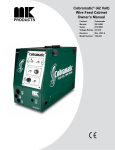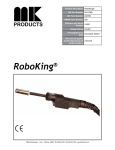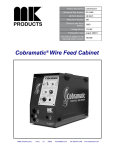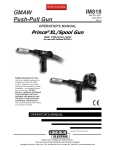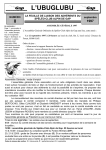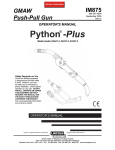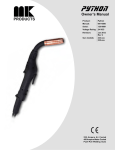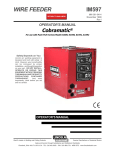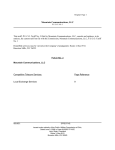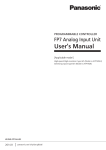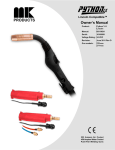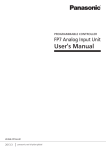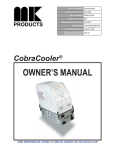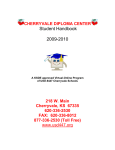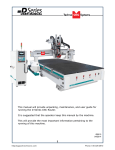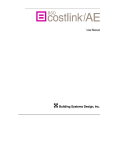Download Owner`s Manual Cobramatic® II Wire Feed Cabinet
Transcript
Cobramatic® II Wire Feed Cabinet Owner’s Manual Product: Cobramatic II Cabinet Manual: 091-0392 Serial: 03040001 Voltage Rating: 42 VAC 100 VAC Revision: April 2003 Rev D Model Number: 150-004 150-204 SAFETY CONSIDERATIONS ELECTRIC ARC WELDING EQUIPMENT CAUTION : READ BEFORE ATTEMPTING INSTALLATION, OPERATION OR MAINTENANCE OF THIS EQUIPMENT 1-1 INTRODUCTION This equipment is intended for ultimate application by commercial/industrial users and for operation by persons trained and experienced in the use and maintenance of welding equipment. Operation should not be undertaken without adequate training in the use of such equipment. Training is available from many public and private schools or similar facilities. Safe practices in the installation, operation and maintenance of this equipment requires proper training in the art, a careful study of the information provided with the equipment, and the use of common sense. Rules for safe use are generally provided by suppliers of welding power sources, compressed gas suppliers, and electrode suppliers. Careful compliance with these rules will promote safe use of this equipment. The following Safety Rules cover some of the more generally found situations. READ THEM CAREFULLY. In case of any doubt, obtain qualified help before proceeding. 1-2 GENERAL PRECAUTIONS A. Burn Prevention ELECTRIC ARC WELDING PRODUCES HIGH INTENSITY HEAT AND ULTRAVIOLET RADIANT ENERGY WHICH MAY CAUSE SERIOUS AND PERMANENT EYE DAMAGE AND WHICH MAY DAMAGE ANY EXPOSED SKIN AREAS. Wear helmet with safety goggles or glasses with side shields underneath, appropriate filter lenses or plates (protected by clear cover glass). This is a must for welding or cutting (and chipping) to protect the eyes from radiant energy and flying metal. Replace cover glass when broken, pitted, or spattered. Medical first aid and eye treatment. First aid facilities and a qualified first aid person should be available for each shift unless medical facilities are close by for immediate treatment of flash burns of the eyes and skin burns. Wear protective clothing - leather (or asbestos) gauntlet gloves, hat, and high safety-toe shoes. Button shirt collar and pocket flaps, and wear cuffless trousers to avoid entry of sparks and slag. Avoid oily or greasy clothing. A spark may ignite them. Flammable hair preparations should not be used by persons intending to weld or cut. Hot metal such as electrode stubs and work pieces should never be handled without gloves. Ear plugs should be worn when working on overhead or in a confined space. A hard hat should be worn when others work overhead. B. Toxic Fume Prevention WARNING: The use of this product may result in exposure to chemicals known to the State of California to cause cancer and birth defects or other reproductive harm. Adequate ventilation. Severe discomfort, illness or death can result from fumes, vapors, heat, or oxygen enrichment or depletion that welding (or cutting) may produce. Prevent them with adequate ventilation. NEVER ventilate with oxygen. Lead-, cadmium-, zinc-, mercury-, beryllium-bearing and similar materials, when welded or cut, may produce harmful concentrations of toxic fumes. Adequate local exhaust ventilation must be used, or each person in the area, as well as the operator, must wear an air-supplied respirator. For beryllium, both must be used. Metals coated with or containing materials that emit toxic fumes should not be heated unless coating is removed form the work surface, the area is well ventilated, or the operator wears an air-supplied respirator. Work in a confined space only while it is being ventilated and, if necessary, while wearing an air-supplied respirator. Gas leaks in a confined space should be avoided. Leaked gas in large quantities can change oxygen concentration dangerously. Do not bring gas cylinders into a confined space. Leaving confined space, shut OFF gas supply at source to prevent possible accumulation of gases in the space if downstream valves have been accidentally opened or left open. Check to be sure that the space is safe before reentering it. Vapors from chlorinated solvents can be decomposed by the heat of the arc (or flame) to form PHOSGENE, a highly toxic gas, and other lung and eye irritating products. The ultraviolet (radiant) energy of the arc can also decompose trichloroethylene and perchloroethylene vapors to form phosgene. DO NOT WELD or cut where solvent vapors can be drawn into the welding or cutting atmosphere or where the radiant energy can penetrate to atmospheres containing even minute amounts of trichloroethylene or perchloroethylene. C. Fire and Explosion Prevention Causes of fire and explosion are: com- Cobramatic® II Owner's Manual bustibles reached by the arc, flame, flying sparks, hot slag, or heated material, misuse of compressed gases and cylinders, and short circuits. BE AWARE THAT flying sparks or falling slag can pass through cracks, along pipes, through windows or doors, and through wall or floor openings, out of sight of the goggled operator. Sparks can fly many feet. To prevent fires and explosion: Keep equipment clean and operable, free of oil, grease, and (in electrical parts) of metallic particles that can cause short circuits. If combustibles are in area, do NOT weld or cut. Move the work if practicable, to an area free of combustibles. Avoid paint spray rooms, dip tanks, storage areas, ventilators. If the work cannot be moved, move combustibles at least 35 feet away, out of reach of sparks and heat; or protect against ignition with suitable and snug-fitting, fire-resistant covers or shields. Walls touching combustibles on opposite sides should not be welded on (or cut). Walls, ceilings, and floor near work should be protected by heat-resistant covers or shields. Fire watcher must be standing by with suitable fire extinguishing equipment during and for some time after welding or cutting if: 1. Appreciable combustibles (including building construction) are within 35 feet. 2. Appreciable combustibles are further than 35 feet, but can be ignited by sparks. 3. Openings (concealed or visible) in floors or walls within 35 feet may expose combustibles to sparks. 4. Combustibles adjacent to walls, ceilings, roofs, or metal partitions can be ignited by radiant or conducted heat. Hot work permit should be obtained before operation to ensure supervisor’s approval that adequate precautions have been taken. After work is done, check that area is free of sparks, glowing embers, and flames. An empty container that held combustibles, or that can produce flammable or toxic vapors when heated, must never be welded on or cut, unless container has first been cleaned in accordance with industry standards. This includes: a thorough steam or caustic cleaning (or a solvent of water washing, depending on the combustible’s solubility), followed by purging and inerting with nitrogen or carbon dioxide, and using protective equipment. Water-filling just below working level may substitute for inerting. A container with unknown contents should be cleaned (see paragraph above). Do NOT depend on sense of smell or sight to determine if it is safe to weld or cut. Hollow castings or containers must be vented before welding or cutting. They can explode. Explosive atmospheres. NEVER weld or cut where the air may contain flammable dust, gas, or liquid vapors (such as gasoline). D. Compressed Gas Equipment The safe handling of compressed gas equipment is detailed in numerous industry publications. The following general rules cover many of the most common situations. 1. Pressure Regulators Regulator relief valve is designed to protect only the regulator from overpressure; it is not intended to protect any downstream equipment. Provide such protection with one or more relief devices. Never connect a regulator to a cylinder containing gas other than that for which the regulator was designed. Remove faulty regulator from service immediately for repair (first close cylinder valve). The following symptoms indicate a faulty regulator: Leaks - if gas leaks externally. Excessive Creep - if delivery pressure continues to rise with downstream valve closed. Faulty Gauge - if gauge pointer does not move off stop pin when pressurized, nor returns to stop pin after pressure release. Repair. Do NOT attempt repair. Send faulty regulators for repair to manufacturer’s designated repair center, where special techniques and tools are used by trained personnel. 2. Cylinders Cylinders must be handled carefully to prevent leaks and damage to their walls, valves, or safety devices: Avoid electrical circuit contact with cylinders including third rails, electrical wires, or welding circuits. They can produced short circuit arcs that may lead to a serious accident. (See 1-3C) ICC or DOT marking must be on each cylinder. It is an assurance of safety when the cylinder is properly handled. Identifying gas content. Use only cylinders with name of gas marked on them; do not rely on color to identify gas content. Notify supplier if unmarked. NEVER DEFACE or alter name, number, or other markings on a cylinder. It is illegal and hazardous. Empties: Keep valves closed, replace caps securely; mark MT; keep them separate from FULLS, and return promptly. Prohibited use. Never use a cylinder or its contents for other than its intended use, NEVER as a support or roller. Locate or secure cylinders so they cannot be knocked over. Passageways and work areas. Keep cylinders clear of areas where they may be stuck. Transporting cylinders. With a crane, use a secure support such as a platform or cradle. Do NOT lift cylinders off the ground by their valves or caps, or by chains, slings, or magnets. Do NOT expose cylinders to excessive heat, sparks, slag, and flame, etc. that may cause rupture. Do not allow contents to exceed 55 degrees C (130 degrees F.) Cool with water spray where such exposure exists. Protect cylinders, particularly valves from bumps, falls, falling objects, and weather. Replace caps securely when moving cylinders. Stuck valve. Do NOT use a hammer or wrench to open a cylinder valve that cannot be opened by hand. Notify your supplier. Mixing gases. NEVER try to mix any gases in a cylinder. NEVER refill any cylinder. Cylinder fittings should never be modified or exchanged. 3. Hose Prohibited use. Never use hose other than that designed for the specified gas. A general hose identification rule is: red for fuel gas, green for oxygen, and black for inert gases. Use ferrules or clamps designed for the hose (not ordinary wire or other substitute) as a binding to connect hoses to fittings. No copper tubing splices. Use only standard brass fittings to splice hose. Avoid long runs to prevent kinks and abuse. Suspend hose off ground to keep it from being run over, stepped on, or otherwise damaged. Match regulator to cylinder. Before connecting, check that the regulator label and cylinder marking agree, and that the regulator inlet and cylinder outlet match. NEVER Connect a regulator designed for a particular gas or gases to a cylinder containing any other gas. Tighten connections. When assembling threaded connections, clean and smooth seats where necessary. Tighten. If connection leaks, disassemble, clean, and retighten, using properly fitting wrench. Adapters. Use a CGA adapter (available from your supplier) between cylinder and regulator, if one is required. Use two wrenches to tighten adapter marked RIGHT and LEFT HAND threads. Regulator outlet (or hose) connections may be identified by right hand threads for oxygen and left hand threads (with grooved hex on nut or shank) for fuel gas. 5. Pressurizing Steps: Drain regulator of residual gas through suitable vent before opening cylinder (or manifold valve) by turning adjusting screw in (clockwise). Draining prevents excessive compression heat at high pressure seat by allowing seat to open on pressurization. Leave adjusting screw engaged slightly on single-stage regulators. Stand to side of regulator while opening cylinder valve. Open cylinder valve slowly so that regulator pressure increases slowly. When gauge is pressurized (gauge reaches regulator maximum) leave cylinder valve in following position: for oxygen and inert gases, open fully to seal stem against possible leak; for fuel gas, open to less than one turn to permit quick emergency shut-off. Use pressure charts (available from your supplier) for safe and efficient recommended pressure settings on regulators. Check for leaks on first pressurization and regularly thereafter. Brush with soap solution. Bubbles indicate leaks. Clean off soapy water after test; dried soap is combustible. Coil excess hose to prevent kinks and tangles. E. User Responsibilities Protect hose from damage by sharp edges, and by sparks, slag, and open flame. Remove leaky or defective equipment from service immediately for repair. Read and follow user manual instructions. Examine hose regularly for leaks, wear, and loose connections. Immerse pressured hose in water; bubbles indicate leaks Repair leaky or worn hose by cutting area out and splicing. Do NOT use tape. 4. Proper Connections Clean cylinder valve outlet of impurities that may clog orifices and damage seats before connecting regulator. Except for hydrogen, crack valve momentarily, pointing outlet away from people and sources of ignition. Wipe with a clean, lintless cloth. Cobramatic® II Owner's Manual Follow all Safety Rules. F. Leaving Equipment Unattended Close gas supply at source and drain gas. G. Rope Staging-Support Rope staging-support should not be used for welding or cutting operation; rope may burn. 1-3 ARC WELDING Comply with precautions in 1-1, 1-2, and this section. Arc Welding, properly done, is a safe process, but a careless operator invites trouble. The equipment carries high currents at significant voltages. The arc is very bright and hot. Sparks fly, fumes rise, ultraviolet and infrared energy radiates, weldments are hot, and compressed gases may be used. The wise operator avoids unnecessary risks and protects himself and others from accidents. Viewing the weld. Provide face shields for all persons who will be looking directly at the weld. A. Burn Protection Generator engine exhaust must be vented to the outside air. Carbon monoxide can kill. Comply with precautions in 1-2. The welding arc is intense and visibly bright. Its radiation can damage eyes, penetrate lightweight clothing, reflect from light-colored surfaces, and burn the skin and eyes. Skin burns resemble acute sunburn; those from gas-shielded arcs are more severe and painful. DON’T GET BURNED; COMPLY WITH PRECAUTIONS. 1. Protective Clothing Wear long-sleeve clothing in addition to gloves, hat, and shoes. As necessary, use additional protective clothing such as leather jacket or sleeves, flameproof apron, and fire-resistant leggings. Avoid outer garments of untreated cotton. Bare skin protection. Wear dark, substantial clothing. Button collar to protect chest and neck, and button pockets to prevent entry of sparks. 2. Eye and Head Protection Protect eyes from exposure to arc. Eyes may be damaged by radiant energy when exposed to the electric arc, even when not looking in the direction of the arc. Never look at an electric arc without protection. Welding helmet or shield containing a filter plate shade no. 12 or denser must be used when welding. Place over face before striking arc. Protect filter plate with a clear cover plate. Cracked or broken helmet or shield should NOT be worn; radiation can be passed through to cause burns. Cracked, broken, or loose filter plates must be replaced IMMEDIATELY. Replace clear cover plate when broken, pitted, or spattered. Flash goggles with side shields MUST be worn under the helmet to give some protection to the eyes should the helmet not be lowered over the face before an arc is struck. Looking at an arc momentarily with unprotected eyes (particularly a high intensity gas-shielded arc) can cause a retinal burn that may leave a permanent dark area in the field of vision. 3. Protection of Nearby Personnel Enclose the welding area. For production welding, a separate room or enclosed bay is best. In open areas, surround the operation with low-reflective, noncombustible screens or panels. Allow for free air circulation, particularly at floor level. Others working in area. See that all persons are wearing flash goggles. Before starting to weld, make sure that screen flaps or bay doors are closed. B. Toxic Fume Prevention Comply with precautions in 1-2B. C. Fire and Explosion Prevention Comply with precautions in 1-2C. Equipment’s rated capacity. Do not overload arc welding equipment. It may overheat cables and cause a fire. Loose cable connections may overheat or flash and cause afire. Never strike an arc on a cylinder or other pressure vessel. It creates a brittle area that can cause a violent rupture or lead to such a rupture later under rough handling. D. Compressed Gas Equipment Comply with precautions in 1-2D. E. Shock Prevention Exposed electrically hot conductors or other bare metal in the welding circuit, or in ungrounded, electrically-HOT equipment can fatally shock a person whose body becomes a conductor. DO NOT STAND, SIT, LIE, LEAN ON, OR TOUCH a wet surface when welding without suitable protection. To protect against shock: Keep body and clothing dry. Never work in damp area without adequate insulation against electrical shock. Stay on a dry duckboard, or rubber mat when dampness or sweat cannot be avoided. Sweat, sea water, or moisture between body and an electrically HOT part - or grounded metal - reduces the body surface electrical resistance, enabling dangerous and possibly lethal currents to flow through the body. 1. Grounding the Equipment When installing, connect the frames of each unit such as welding power source, control, work table, and water circulator to the building ground. Conductors must be adequate to carry ground currents safely. Equipment made electrically HOT by stray currents may shock, possibly fatally. Do NOT GROUND to electrical conduit, or to a pipe carrying ANY gas or a flammable liquid such as oil or fuel. Three-phase connection. Check phase requirement of equipment before installing. If only three-phase power is available, connect single-phase equipment to only two wires of the three-phase line. Do NOT connect the equipment ground lead to the third (live) wire, or the equipment will become electrically HOT - a dangerous condition that can shock, possibly fatally. Before welding, check ground for continuity. Be sure conductors are touching bare metal Cobramatic® II Owner's Manual of equipment frames at connections. If a line cord with a ground lead is provided with the equipment for connection to a switch box, connect the ground lead to the grounded switch box. If a three-prong plug is added for connection to a grounded mating receptacle, the ground lead must be connected to the ground prong only. If the line cord comes with a three-prong plug, connect to a grounded mating receptacle. Never remove the ground prong from a plug, or use a plug with a broken ground prong. 2. Connectors Fully insulated lock-type connectors should be used to join welding cable lengths. 3. Cables Frequently inspect cables for wear, cracks, and damage. IMMEDIATELY REPLACE those with excessively worn or damaged insulation to avoid possibly lethal shock from bared cable. Cables with damaged areas may be taped to give resistance equivalent to original cable. Keep cable dry, free of oil and grease, and protected from hot metal and sparks. 4. Terminals and Other Exposed Parts Terminals and other exposed parts of electrical units should have insulating covers secured before operation. 5. Electrode Wire Electrode wire becomes electrically HOT when the power switch of gas metal-arc welding equipment is ON and welding gun trigger is pressed. Keep hands and body clear of wire and other HOT parts. 6. Safety Devices Safety devices such as interlocks and circuit breakers should not be disconnected or shunted out. Before installation, inspection, or service of equipment, shut OFF all power, and remove line fuses (or lock or red-tag switches) to prevent accidental turning ON of power. Disconnect all cables from welding power source, and pull all 115 volts line-cord plugs. Do not open power circuit or change polarity while welding. If, in an emergency, it must be disconnected, guard against shock burns or flash from switch arcing. Leaving equipment unattended. Always shut OFF, and disconnect all power to equipment. Power disconnect switch must be available near the welding power source. Thank You For selecting a quality product. We want you to take pride in operating this product...as much pride as we have in bringing the product to you! Please Examine Carton and Equipment For Damage Immediately When this equipment is shipped, title passes to the purchaser upon receipt by the carrier. Consequently, claims for material damaged in shipment must be made by the purchaser against the transportation company at the time the shipment is received. Please record your equipment identification information below for future reference. This information can be found on your machine nameplate. Model Name & Number _____________________ Code & Serial Number _____________________ Date of Purchase _____________________ Whenever you request replacements parts for, or information on this equipment always supply the information you have recorded above. Read this Owner’s Manual completely before attempting to use this equipment. Save this manual and keep it handy for quick reference. Pay particular attention to the safety instructions we have provided for your protection. Cobramatic® II Owner's Manual Table of Contents Safety Guidlines....................................................... i-iv Installation...................................................... Section A Technical Specifications........................................................ Machine Grounding ............................................................. Machine Location ............................................................... Contactor Selection............................................................. Input Power Connections ...................................................... Wire Threading Procedure ..................................................... Torch Drive Roll Adjustment................................................... 1 1 1 1 2 2 4 Operation ....................................................... Section B General Description ............................................................ Controls and Settings........................................................... Controls for Optional Timer Kit ............................................... Controls for Optional Meter Kit ............................................... Posa Start Operating Procedure .............................................. Remote/Automatic Operation ................................................ Performance and Fault Isolation Indicators ................................. Wire Feed Calibration Procedure ............................................. 4 4 5 6 6 8 8 8 Accessories...................................................... Section C Optional Kits ..................................................................... 9 Maintenance .................................................... Section D Routine Maintenance .......................................................... 10 Recommended Spare Parts ................................................... 10 Testing the Torch ............................................................... 10 Testing the 115VAC Circuits .................................................. 10 Troubleshooting ................................................ Section E Slave Motor Tension Test ...................................................... 11 Troubleshooting Main Board .................................................. 12 Troubleshooting Guide ........................................................ 13 Appendices...................................................... Section F Figures ........................................................................... 16 Exploded Parts View ........................................................... 21 Electrical Schematics.......................................................... 27 Warranty Repair Stations Safety Warnings Warranty Cobramatic® II Owner's Manual THIS PAGE INTENTIONALLY BLANK Cobramatic® II Owner's Manual SECTION A INSTALLATION TECHNICAL SPECIFICATIONS Wire Diameter Capacity .030 - 1/16" ALL Types Wire Capacity 12" Standard (Insulated or Non-Insulated) Power Input 42 VAC 50/60 Hz 110 VAC 50/60 Hz 150 Watts Peak Wire Feed Rate (Depending on Torch used) 10--1000 ipm Weight 31 pounds Shipping Weight 37 pounds Compatible Torches All MK 7pin Amphenol Plug Mig Torches MK RoboKing Automated Torch SUPPORT EQUIPMENT REQUIRED MK 2000A Power Supply or any C. V. or C.C. power source of sufficient capacity for your needs. Regulated gas supply and hoses. Properly sized power leads from power source to wire feeder and ground. Water source and hose capable of providing a minimum of 1 qt/min. at 45 p.s.i. when using water cooled torches. COOLANT RECOMMENDATIONS Use a name-brand additive which does not contain reactive sulphur or chlorine and does not react with copper, brass, or aluminum. Here's also mixture that works well : Use 3 Gallons (11.4 Liters) deionized water. (NOT DISTILLED) Use 1 Gallon (3.8 Liters) ethleyne glycol. Use 1 tsp (5 ml) liquid glycerin per gallon (3.8 Liters) of mixture Check coolant periodically to remain within limits of the following: Coolant Flow rate - 1 quart/minute at 45 p.s.i. Resistivity - 10K ohms/centimeter Ph Range - 5.5-8.5 Particle Size - .005" MACHINE GROUNDING The Cobramatic®II and GMAW wire feeders are ground to the power source through the input cable. The power source grounding terminal must be properly connected to electrical ground per the power source operating manual. MACHINE LOCATION The cabinet should be placed in a location where it can be protected from damage. Lead lengths and accessibility to input power(42/110VAC 50/60 Hz) must also be considered when installing the cabinet. CONTACTOR SELECTION - (FIG. 1) The Cobramatic® II is shipped from the factory in the closing contacts position. A six foot (6') contactor cable is supplied with the unit to which the black and white wires supply the contactor signal. If a 115 VAC contactor out signal is required, remove the screws from the left Cobramatic® II Owner's Manual - Page 1 side of the cabinet and open door. Locate the black and white wire on #2 and #3 of terminal strip J16. Move black wire to #4 and white wire to #3 of terminal strip J15. The unit will now supply 115 VAC on the black (hot) and white (neutral) wires. NOTE: Refer to the power supply owner’s manual for location and type of contactor signal required. WARNING: Disconnect the Cobramatic® Cabinet from all power sources before changing contactor. INPUT CONNECTIONS POWER CONNECTIONS - (FIG. 2) Connect the supplied 6' three (3) prong plug to a 115 VAC 50/60 Hz outlet. (For 42VAC export cabinets, no input power cord is provided.) The input power cord is connected to the PC Board on terminal strip J15 #1 (neutral) and #2 (hot) and Ground to the cabinet chassis. POSA START CONNECTIONS - (FIG. 2) When using a Constant Voltage (CV) Power source such as the MK2000A, the Posa Start lead need not be connected and switch 3 should be placed in the "INT" position. The Posa Start lead is internally connected to the P.C. board on terminal strip J16 terminal #1. When using a Constant Current (CC) Power Source, attach the No. 14 single black lead which extends from the back of the Cobramatic® II to the negative terminal of the welding power source or work ground. Switch 3 must also be in the “EXT” position. CABLE CONNECTIONS - (FIG. 3) Connect the positive power cable (DCEP) from the power supply to the bottom hole on the power block and secure with bolt. GAS HOSE - (FIG. 3) Connect hose from regulator/flowmeter to the fitting on the power block using a 5/8"-18 IAA R.H. Gas fitting. WATER CONNECTIONS - (FIG. 3) When using a water cooled torch, connect the 5/8"-18 L.H. male fitting extending from the torch lead assemblies to your water supply line. The water return also uses a 5/8"-18 L.H. male fitting and connects to the lefthand fitting on the power block. WIRE THREADING PROCEDURE WIRE SPOOL INSTALLATION Release latches, and open right side door of cabinet. Remove spool retainer from spindle hub. Install wire spool onto spindle hub so that wire feeds from bottom of spool towards slave motor. Make sure that the hole in the spool aligns with pin on spindle hub. The white dot on the end of the spindle hub will aid in this alignment. Replace the spool retainer. Cobramatic® II Owner's Manual - Page 2 THREADING PROCEDURE Place wire size selector switch on front panel to the correct position for the wire being used. NOTE: For 3/64" and 1/16" aluminum wire use the "ALL OTHER WIRES" position. Loosen end of wire from spool and cut off any kinked or bent portions. Unreel and straighten out first 6" to 8" of wire. Release tension from slave motor drive rolls. Route wire into inlet guide, along drive roll groove, and into wire conduit. Prevent the wire spool from turning with the palm of the right hand, and at the same time grasp the slave motor pressure adjusting knob. Pull the torch trigger and slowly tighten the slave motor pressure adjusting knob until the slave motor stalls; then add an additional 1/4 turn more. CAUTION: EXCESSIVE DRIVE ROLL TENSION WILL REDUCE RATHER THAN IMPROVE WIRE FEED PERFORMANCE. Tighten the torch pressure adjusting knob so the wire will be picked up and fed through the contact tip. Proper tension is achieved when wire does not slip if a small amount of pressure is added to the wire as it exits the tip. SPINDLE DRAG ADJUSTMENT Loosen nut inside spindle until spring is not compressed. When in the ".030-.035 Aluminum Only" position, tighten nut until you feel spring start to compress then add 1 turn. Press the trigger and make sure the wire comes level off of the spool. If you can see the wire cast when feeding, add a little more drag. (1/4 turn) When in the "All Other Wires" position, start with 3 turns of drag and adjust. PRE-SETTING SLAVE MOTOR TENSION All Cobramatic®s have preset adjusting nuts which enables spools of the same wire diameter and type to be changed without further pressure adjustment after initial set-up. To preset the slave motor tension bottom out the pressure adjusting knob by turning it completely clockwise. Prevent the wire spool from turning and using a 9/16" wrench adjust the preset nut until the slave motor stalls, then add an additional 1/4 turn. Correct pressure will now be achieved by simply bottoming out the pressure adjusting knob. WIRE GUARD The Cobramatic® Wire Guard (P/N 005-0618) is designed to keep the welding wire from jumping off the spool inside the wire feed cabinet. When the trigger is released and the brake engages, especially when using a new spool that is heavier towards the outside, the spool will tend to rotate more against the spindle drag adjustment. However, since the wire is held by the slave motor it will not move and could subsequently jump off the back of the spool and become lodged in the brake mechanism, or jump off the front of the spool and electrically short-out to the cabinet chassis. The wire guard will keep the wire from doing either. The wire guard is designed to run inside the spool on top of the wire, and when the brake is engaged the wire guard will hold the wire onto the spool. The wire guard is made of a heavy woven nylon material that is resistant to Cobramatic® II Owner's Manual - Page 3 wear and will not contaminate the surface of the wire TORCH DRIVE ROLL ADJUSTMENT ----------- IMPORTANT ----------NOTE: Over-tightening of the drive rolls will cause excessive knurling and/or deformation of the wire. When the complete system is set-up properly, feeding wire out of the end of the torch and letting fall on the ground should form a large uniform circle. If it forms a spiral or spring then there is too much tension in the system, please refer to the Cabinet Owners Manual for adjustment to the tension setting detailed there. THIS IS THE NUMBER ONE CAUSE OF POOR WIRE FEED PERFORMANCE --------------------------------------------- SECTION B OPERATION GENERAL DESCRIPTION The Cobramatic® II is an analog input version of the popular Cobramatic® I Cabinet and operates on the same basic principles. The AC slave motor in the feeder runs at a fast, constant speed, but has very low torque. It is always trying to feed more wire than the torch motor wants, and when the motor gets all it wants, it slows the slave motor preventing a bird’s nest. Because of the low torque produced by the slave motor, a brake system is used to prevent wire overrun rather than tension. The drag adjustment in the spindle is used to keep the wire slightly taut, so it will not unspool while feeding wire. The high torque 24 VDC torch pull motor is controlled by a solid state speed control and a potentiometer located in the torch, feeder or remotely. The solid state control circuit provides a wide range of operating conditions and includes performance and fault isolation L.E.D. indicators. The wire feed speed command can be derived from the cabinet, torch, or from a 0-10 volt analog external signal. A variety of input/output signals make it highly suitable for automatic applications. CONTROLS AND SETTINGS (SEE FIG. 4) ON/OFF SWITCH Placing the switch in the “ON” position energizes the feeder circuitry and the power indicator light. WIRE SIZE SELECTOR SWITCH The wire size selector switch changes the torque of the slave motor for the wire you are using. When in the ".030-.035 Aluminum Only Position", the slave motor produces approximately 1 1/2 lbs. inches and approximately 4 1/2 lbs. inches when in the "All Other Wires Position." NOTE: Operating the cabinet with the switch in the wrong position will cause wire feed difficulties. POSA START CONTROL When in the "ON" position, the wire feed command is derived from the Posa Start potentiometer. After arc initiation, the wire feed speed is controlled by the selected wire feed source, i.e., torch, cabinet, or remotely. WIRE INCH The Wire Inch button causes wire feed at the weld feed rate from the selected source, independent of Posa Start and may be used to observe or time Cobramatic® II Owner's Manual - Page 4 the weld wire feed rate without turning Posa Start off. The contactor is not activated during "Wire Inch". (NOTE: If the wire feed speed is set to accept a remote source, and no input command voltage is present, no wire feed will occur). TORCH ELECTRICAL RECEPTACLE The Cobramatic® II has a 7 pin “W” clocked Amphenol connector to provide an electrical connecting point to the torch. See specifications for more information. CABINET WIRE FEED SPEED POTENTIOMETER (OPTIONAL - P/N 005-0166) By selecting the cabinet potentiometer, the wire feed speed may be adjusted from the cabinet. See wire speed source, section 9.4. The counter dial directly reads in inches per minute (0 to 1000 IPM). POWER CABLE INLET The Power Inlet provides access to the power block fitting inside the cabinet. CONDUIT INLET The Conduit Inlet provides access to the slave motor outlet guide. SHIELDING GAS INLET Provides access to the gas fitting inside the cabinet. CONTROLS FOR OPTIONAL TIMER KIT (P/N 005-0196) WATER INLET Provides access to make the gun water connection to recirculator hose. GAS PURGE The Gas Purge button operates the gas solenoid in the cabinet. When the solenoid in the cabinet is used, a modified gas valve, P/N 431-1080, must be installed in the torch. PRE-PURGE The smaller knob on the pre/post purge control may be turned clockwise to increase the pre-purge interval. The control cannot be turned off and provide a range of approximately .07 to 3.4 seconds. When the trigger is depressed, the gas solenoid will open, and all other functions will be inhibited until the end of the pre-purge interval, when normal welding will start. If the trigger is released during pre-purge, no weld will be initiated. POST-PURGE The larger knob on the pre/post purge control may be turned clockwise to increase the post-purge interval. This control cannot be turned off and provides approximately .07 to 4.5 seconds of post flow. The post-purge will not activate unless an arc has been established. BURN BACK The larger knob on the spot time/Burn-back control may be turned clockwise to increase the burn-back interval. During this interval, all functions except wire feed are maintained and, thus, the arc burns the wire back towards the tip. Excessive burn-back may result in damage to the contact tip. The burnback control must be clicked on and is adjustable from .015 to .085 seconds. The burn-back control is not activated until an arc has been established. SPOT TIME The spot timer has the capability to time and terminate a weld cycle following a trigger ON command. The spot time function is initiated once the arc is Cobramatic® II Owner's Manual - Page 5 established, and, even if the trigger is held ON or released, the cycle will end at the spot timer time out. To initiate a new cycle, the trigger must be turned OFF (released) and re-triggered. The spot time knob must be clicked ON and the duration may be set from .07 to 3 seconds. The spot time may be used with all other functions; pre-purge, burn-back, post-purge. NOTE: Even with the spot timer turned "ON", the wire will not time out until you strike an arc. This provides very accurate, repetitive timing. CONTROLS FOR OPTIONAL METER KIT (P/N 005-0190) The LED meter provides a continuous reading of wire feed speed in inches per minute. When the trigger is energized, the meter will display weld voltage. POSA START OPERATING PROCEDURE GENERAL DESCRIPTION The Posa Start feature allows the Cobramatic® II to be used in combination with constant current DC welding power sources of open circuit voltage in excess of 55 volts - also, any constant voltage welding power source capable of a minimum of 50 amps. NOTE: Reverse polarity MUST be used. The Posa Start MUST be used with a Constant Current power source to provide arc initiation and may be used with a Constant Voltage power supply to help eliminate burn-backs at arc start. CAUTION: DO NOT OPERATE A Cobramatic® II ON A POWER SOURCE HAVING A HIGHFREQUENCY STARTING CIRCUIT BEFORE MAKING SURE THAT THE HIGHFREQUENCY PORTION OF THE POWER SOURCE IS TURNED OFF. FAILURE TO TAKE THIS PRECAUTION WILL CAUSE PERMANENT DAMAGE TO THE POSA START CIRCUITRY. The Posa Start Run-in Speed Control, located on the front panel, provides adjustment for slow wire run-in. Once the arc has been established, the wire feed speed is automatically changed from the slow run-in speed to the welding speed. The Posa Start does not control the wire speed while welding. CV POSA START OPERATION Attach Cobramatic® II to CV power source according to the installation instructions. Turn the Cobramatic® II to the “ON” position and the Posa Start to the “OFF” position. Adjust power source to desired voltage for your weld condition. Depress gun trigger and adjust wire feed speed to match voltage setting. If approximate wire feed is not known, it is better to start with excess wire feed rather than too little, in order to prevent a “burn-back”. Turn the Posa Start switch to the “ON” position. Press torch trigger and, using Run-in Speed Control, adjust wire feed rate to approximately 10% of the welding wire speed. Strike an arc, and adjust wire feed rate at gun until correct condition is achieved. CC POSA START OPERATION Attach the Cobramatic® II to a CC power source according to the installation instructions. Cobramatic® II Owner's Manual - Page 6 Insure power supply high frequency switch is in the “OFF” position, and power supply is set to DC reverse polarity. The power supply contactor should be set to “Remote” or “Tig” and the amperage control set to “Panel” or “Standard” depending on power supply. Turn the Cobramatic® II power switch to the “ON” position and the Posa Start switch to the “OFF” position. Adjust power source to desired amperage for your weld condition. Press gun trigger and adjust wire feed speed at gun to match current setting. If approximate wire feed speed is not known, it is better to start with excess wire feed rather than too little, in order to prevent possible damage to the contact tip. Turn Posa Start switch to the “ON” position. Press torch trigger and, using Run-in Speed Control, adjust wire feed speed to approximately 10% of the welding wire speed. Strike an arc; if the wire stubs out, reduce wire feed rate at gun, or increase amperage setting on power source. NOTE: Because the Posa Start Run-in Speed always remains a percentage of the actual welding wire feed rate, the Posa Start run-in speed will always slow down or speed up proportional to any adjustment you now make at the gun. Therefore, if you slow down the welding wire feed speed, you will have to increase the Run-in Speed setting. WIRE SPEED SOURCE (S1) (FIGURE 5) The wire feed command may be obtained from the torch, cabinet, or from a 0-10VDC analog signal by simply changing switch 1 (S1) settings. S1, a four-position dip switch, is located in the upper left hand corner of the Main PC Board and set as follows: NOTE : Only one switch may be "ON" at a time. SWITCH 1 SETTINGS (S1) (FIGURE 5) Position #1 #2 #3 #4 No connection (NC) Selects cabinet potentiometer. (opt) Selects torch potentiometer. Selects a remote 0-10VDC analog signal command through a 5K ohm potentiometer: J22-1 J22-3 TP5 Ground Wiper 10VDC or external source TORCH COMPENSATING NETWORK (S2) The Cobramatic® II circuit provides for linear control of the wire feed from less than one volt to ten volts. The torch compensating network is provided to match the torch motor gearbox ratio to the 0-10VDC linear control. Therefore, regardless of which type of torch is used, one volt will equal 100 ipm, two volts equals 200 ipm, etc. To set up the network for the torch you are using, locate dip switch 2 (S2) in the upper left corner of the Main PC Board, and set as follows: NOTE: Only one switch may be "ON" at a time. Cobramatic® II Owner's Manual - Page 7 SWITCH 2 SETTINGS (S2) Position #1 #2 #3 #4 #5 Cobra System III Torches (800ipm) Cobra Gold Torches RoboKing Torches Python CobraMax Prince (750ipm) King Cobra (700ipm) Prince XL not used (future) During Posa Start Run-In Interval, the network is bypassed to permit very smooth, slow run-in to be achieved. See wire feed calibration section for torch calibration procedure. REMOTE/AUTOMATIC OPERATION (FIG. 5) The Cobramatic® II cabinet may be set up to operate in a wide variety of automatic and semi-automatic applications. The remote input/output connector (J22) provides the electrical interface to your equipment. When the Cobramatic® is used in this capacity, timer kit, P/N 005-0196, should be installed to provide control of the gas, as well as spot time and burn-back functions, see optional kits. PERFORMANCE & FAULT ISOLATION INDICATORS GENERAL The Cobramatic® II is equipped with LED indicators to aid in operation and trouble- shooting. The indicators check out individual circuits, respond to signals, and indicate overload conditions. DETAILED OPERATION When the cabinet is turned “ON”, D6 and D10, both green LED’s, will light. D6 indicates that 27VAC is being supplied to the board, and D10 indicates the presence of the 10VDC. When the trigger signal is supplied, either from the torch or remotely, D21 (trigger), a yellow LED, will light. After the pre-purge times out, D19 (wire forward), D34 (torch motor voltage) and D31 (Slave motor voltage), all yellow LED’s will light, and the welding wire will begin to feed. (Note: If the timer kit, P/N 005-0196, is not installed, D19 (wire forward), D34 (torch motor voltage), and D31 (115vac) indicators will light with the trigger signal. D34 indicates the presence of the torch motor voltage, whereas D31 indicates the presence of AC voltage for the brake solenoid and slave motor. When the arc is initiated, D17 (arc establish), a yellow LED, will light and remain on until the arc is extinguished. D39, a red LED when lit, indicates a torch overload condition has occurred. Turn main power switch “OFF”, then back “ON” to reset. See trouble-shooting section, for more information. WIRE FEED CALIBRATION PROCEDURE CALIBRATION INSTRUCTIONS The Cobramatic® II comes from the factory already calibrated for the torches indicated on the torch selector switch (S2), but further fine-tuning can be done to the motor drive circuit by using trim pots R54 and R69. This adjustment may be necessary due to variations in different torch motor gearboxes, type of drive rolls used, age of torch and many other contributing factors. Each time you use a different torch on the cabinet you may want to re-check this calibration. While this adjustment is not critical for most Cobramatic® II Owner's Manual - Page 8 applications, it is important when using a meter kit on the Cobramatic® II cabinet to make sure the demand and actual wire speeds are the same. It is equally important to maintain proper calibration when using a remote (0-10VDC) input to control wire speed, as this will expect certain results for each demand of input voltage. The goal of this calibration procedure is to have 1 volt of input to equal 100 ipm at the torch, 2 volts equals 200 ipm, etc. 1. Insure that switch 2 (S2) is in the correct position for the torch you are using. 2. Insure that switch 1 (S1) is in the correct position for your control requirements (torch pot, cabinet pot or remote). 3. Set the pre-purge control to off, if so equipped. Turn Posa Start off. 4. Adjust the command voltage (TP11) to 2.00 VDC using the torch pot, cabinet pot or remote command depending on the position of (S1). Use J22-1 for ground reference. 5. Feed out wire for exactly six (6) seconds and measure. You should have 20 inches of wire for a 2 volt command. Repeat and compare the two segments of wire for an average length. 6. If wire length is less than 20 inches (200 IPM), increase (clock wise) R54 and repeat step 5. If wire length is is greater than 20 inches (200 IPM), decrease (counter-clock wise) R54 and repeat step 5. R54 adjustment is approximately 0.5 inches/turn (5 IPM/turn). 7. Adjust the command voltage (TP11) to 6.00 VDC using the torch pot, cabinet pot or remote command depending on the position of (S1), 8. Feed out wire exactly exactly six (6) seconds and measure. You should have 60 inches of wire for a 6 volt command. Repeat and compare the two segments of wire for an average length. 9. If wire length is less than 60 inches (600 IPM), increase (clockwise) R69 and repeat step 5. If wire length is greater than 60 inches (600 IPM), decrease (counter-clockwise) R69 and repeat step 8. R69 adjustment is approximately 1.0 inch/turn (10 IPM/turn). 10. Repeat steps 4 through 9 until the wire speed (IPM) matches the demand voltage (VDC). SECTION C ACCESSORIES Plastic Guides for Slave Motor Inlet Guide . . . . . . . . . . . . . . . . . . . . 753-0062 Outlet Guide with Knob . . . . . . . . . . 003-0428 OPTIONAL KITS Cabinet Potentiometer Kit . . . . . . . . 005-0166 Removes wire feed speed control from the torch to the cabinet and provides a 10-turn counter dial. Timer Kit . . . . . . . . . . . . . . . . . . . . . . 005-0196 Provides pre-purge, post-purge, Burn-back and spot-time Meter Kit . . . . . . . . . . . . . . . . . . . . . . 005-0190 Displays both wire feed speed and weld voltage Preset Adjusting Screw Kit . . . . . . . . 005-0125* Water Flow Kit . . . . . . . . . . . . . . . . . 005-0253 Wire Guard Kit . . . . . . . . . . . . . . . . . 005-0618* *standard on all wire feeders Cobramatic® II Owner's Manual - Page 9 SECTION D MAINTENANCE ROUTINE MAINTENANCE Maintenance of the torch will normally consist of a general cleaning of the wire guide system, including tubes, drive rolls, and conduits at regular intervals. Remove spatter build-up from inside of nozzles with a hardwood stick. The only parts on the Cobramatic® system that are subject to normal wear are the conduit, contact tips, gas cups, front body liners, wire guides, drive and idler rolls. A supply of these parts should be maintained on hand. If repairs do become necessary, any part can easily be replaced by qualified shop maintenance personnel. Your Cobramatic® II is designed to provide years of reliable service. Normal wear and component failure may require occasional service. The number of units in operation and the importance of minimal "down time" will determine to what extent spare parts should be stocked on hand. The following list comprises the most commonly replaced parts. RECOMMENDED SPARE PARTS QTY DESCRIPTION P/N 1 1 or 1 1 or 1 1 1 2+ Brake Solenoid w/leads Main P.C. Board Main P.C. Board (exchange) Front Panel P.C. Board Front Panel P.C. Board (exchange) Slave Motor Drive Roll Slave Motor Idler Roll Fuse AGC 2A 250V 003-2096 003-1977 006-1977 003-1688 006-1688 511-0206 501-0207 151-0001 TESTING THE TORCH MOTOR CHECK Remove the amphenol connector from the cabinet. Using the torch amphenol, check the resistance across pins “A” and “B” (motor leads). The resistance across the motor should be between 5-10 ohms. If an open circuit or short exist, check the motor leads and motor independently. TESTING THE POTENTIOMETER - “W” CLOCKED Using the torch amphenol, check the resistance across pin “D” (wiper) and pin “C”. The resistance should vary from 0 - 5K ohms. Check the resistance across pin “D” (wiper) and pin “G”. The resistance should vary from 5K - 0 ohms. TESTING THE MICRO SWITCH Using the torch amphenol, check for continuity across pins “E” and “F” when the trigger is pressed. TESTING THE 115 VAC CIRCUITS The 115 VAC circuit is protected by fuse F3. If F3 continually blows, remove J10 (Brake Solenoid), J12 (slave motor) and J15-3,4 (115 VAC Contactor) from the P.C. Board. Replace fuse, and retrigger system. If fuse does not blow; isolate the problem by plugging in J10, J12, and J15-3,4 one at a time until the fuse blows. Cobramatic® II Owner's Manual - Page 10 SECTION E TROUBLESHOOTING Regardless of which torch or feeder used, all MK Products push-pull guns operate on the same principle. The 115VAC slave motor in the feeder runs at a fast, constant speed, but has very low torque. It is always trying to feed more wire than the torch motor wants, and when the motor gets all it wants, it slows the slave motor, preventing a bird’s nest. Because of the low torque produced by the slave motor, a brake system is used to prevent wire overrun rather than tension. The drag adjustment in the spindle is used simply to keep the wire slightly taut, so it will not pull off the spool while feeding wire. The 24VDC torch motor is controlled by a solid state speed control and a pot located in the torch, cabinet or remotely. The torch motor, potentiometer, and micro switch are connected to the cabinet via a control cable and amphenol. If this cable becomes damaged, a variety of symptoms can occur, depending on which wire(s) break. To test, check each wire for continuity and shorts. Remember the micro switch in the torch activates both the 115VAC and 24V circuits in the cabinet. Therefore, if the slave motor and brake solenoid operate, but the torch does not, look more toward the 24V circuits, speed control, control cable, or the torch motor. If nothing operates, look more toward the 115VAC input, micro switch leads, or micro switch. The objective of this trouble-shooting section is to identify and replace faulty assemblies, not individual component repairs. SLAVE MOTOR TENSION TEST To check for proper operation of the slave motor, the following test may be performed: Disconnect welding power from Cobramatic® II cabinet. Plug Cabinet into 115VAC power outlet (different for export) and turn cabinet "ON" Remove torch wire conduit from the outlet guide on the slave motor assembly. Cut a piece of .045" hard wire 10" long and make a small loop on one end to attach the spring scale. Place the wire size selector switch on the front panel in the .030 & .035 ALUMINUM ONLY position. Insert the .045" hard wire into slave motor assembly, press trigger, and tighten slave motor drive roll pressure adjusting nut until the drive roll stalls. The spring scale should read about 1 1/2 lbs of pull when the slave motor stalls. Now repeat the test with the wire selector switch set to the "ALL OTHER WIRES" position. Depress the torch trigger and readjust the drive roll pressure adjusting nut until the drive stalls once again. This time the spring scale should read approximately 4 1/2 lbs. TROUBLESHOOTING MAIN BOARD MAIN BOARD - Test Points High - 9 to 10 volts Low - 1 volt or less A voltmeter is required for the following test. TP3 is ground. Turn the unit “OFF” and unplug the J9 connector going to the timer board, if so equipped, from the main board. Turn unit “ON” and set meter to DC. Cobramatic® II Owner's Manual - Page 11 27VAC INPUT Set voltmeter to AC. Place negative on TP1 and positive on TP4; should have 27 to 30VAC at all times. 10V SUPPLY Place negative lead on TP3 and positive on TP5. Should have 10VDC with trigger “ON” or “OFF”. 15V SUPPLY Place negative on TP3 and positive on TP2; should have 14.3 to 15.7VDC at all times. TRIGGER SIGNAL Place negative lead on TP3 and positive on TP8, should be high; press trigger--should go low. WIRE FORWARD SIGNAL Place negative on TP3 and positive on TP9, should be high; press trigger-should go low. TORCH MOTOR VOLTAGE Place negative on TP3 and positive on TP10. Press torch trigger and change wire feed speed potentiometer--should vary from 0-27VDC. INHIBIT CIRCUIT Place negative on TP3 and positive on TP7, should be high; press trigger-should go low. Units with Timer Kit Installed (J9) Follow above steps, except note the following changes: Turn unit “OFF” and plug in the J9 connector. Trigger signal high may only be 7VDC. Inhibit circuit should be low at all times Cobramatic® II Owner's Manual - Page 12 Trouble No wire feed at torch, feeder not operating, i.e. no slave motor or brake solenoid. Brake Solenoid inoperative No wire feed at torch, feeder operating properly. Wire feeds, but welding wire is not energized. Wire feeds erratically. Wire feeds one speed only. Wire walks out of drive rolls. TROUBLESHOOTING GUIDE Cause Remedy F3 (2 amp) fuse in feeder blown. Check 115 VAC circuit. Replace fuse. Micro-switch defective/not being activated. Broken electrical cable. Replace switch. Check switch for operation. Check micro-switch wires for continuity. Loose J13, PC board connector Check J13 connector. Solenoid defective Replace Main PC board defective Check for D31 LED operation/replace board. Switch 1 on Main PC board in wrong position. Select cabinet, torch or remote position. Bad Speed control/PCB Check/replace Main PC board Broken electrical cable Check motor and potentiometer wires for continuity. Bad torch motor (D39 LED “ON”) Check/replace motor. Bad Potentiometer Check potentiometer with ohm meter. Loose or no cable connections Check all power connections Relay K1 not sending contactor signal. Check/replace relay K1. Contactor control cable loose or in wrong position. Check power supply owners manual for location and type of contactor signal required, I.e.; closing or 115VAC. Welding power source Check power source for operation. Excessive spool drag pressure Decrease spool drag pressure inside hub. Dirty or worn conduit. Blow out or replace conduit Incorrect pressure on drive rolls. Adjust pressure at both feeder and torch. Idler roll stuck Check for lock washer under idler roll, or replace if damaged. Wrong size contact tip See contact tip table in torch manual. Bad potentiometer. Check with meter. Broken electrical cable. Check potentiometer wires for continuity or short. Bad speed control. Check/replace Main PC board. Idler roll upside-down. Place groove in idler roll toward top. Rear wire guide missing. Replace wire guide. Cobramatic® II Owner's Manual - Page 13 This page left intentionally blank Cobramatic® II Owner's Manual - Page 14 SECTION F APPENDICES DIAGRAMS Figure Figure Figure Figure Figure 1, 2, 3, 4, 5, AND PARTS LISTS Contactor Hook-up Selection ................................. Input Power and Posa Start Connections ................... Cabinet and Torch Hook-Up Diagram ........................ Front Panel - Controls Layout ................................ Main Board Switch Settings and Remote Connections .... 16 17 18 19 20 001-3070 003-1701 003-1674 003-2078 003-0570 Cobramatic® II Assembly ...................................... 21 Front Panel Assembly .......................................... 23 Power Block Assembly ......................................... 24 Slave Motor Assembly.......................................... 25 Spindle Brake Assembly ....................................... 26 071-0252 071-0296 071-0330 071-0365 071-0366 Multi Function Timer Board................................... Front Panel...................................................... Meter............................................................. Main Board ...................................................... Wiring Diagram ................................................. Cobramatic® II Owner's Manual - Page 15 28 29 30 31 34 CONTACTOR HOOK-UP SELECTION FIGURE 1 CLOSING CONTACTOR J16 WIRE POSITION (As Shipped From Factory) WHITE WIRE BLACK WIRE J15 120VAC CONTACTOR WIRE POSITION WHITE WIRE BLACK WIRE NOTE : BOTH TYPES OF CONTACTOR OUTPUTS ARE AVAILABLE SIMULTANEOUSLY, THERE IS NO SWITCH TO SELECT BETWEEN THE DIFFERENT TYPES, YOU MUST MOVE THE CONTACTOR LEADS BETWEEN TERMINAL STRIPS (J15) AND (J16) Cobramatic® II Owner's Manual - Page 16 INPUT POWER AND POSA START CONNECTIONS FIGURE 2 S3 INT EXT POSA START VOLT SENSE (S3 - see text for correct position) J22 POSA START WORK GROUND CONNECTION BLACK WIRE J16 J15 GROUND TERMINAL INPUT POWER WIRE POSITION WHITE WIRE BLACK WIRE GREEN WIRE Cobramatic® II Owner's Manual - Page 17 CABINET AND TORCH HOOK-UP DIAGRAM FIGURE 3 115VAC Supply Cable Water In Input Power Cable must be connected to bottom hole or Posa-Start will not operate properly! Upper hole is to be used only when connecting to the Prince spoolgun to the cabinet as a push-pull system. Cobramatic® II Owner's Manual - Page 18 FRONT PANEL - CONTROLS LAYOUT FIGURE 4 Cobramatic® II Owner's Manual - Page 19 INT POSA START VOLT SENSE TORCH SELECTIONS WIRE SPEED SELECTIONS MAIN BOARD SWITCH SETTINGS AND REMOTE CONNECTIONS FIGURE 5 S3 S2 S1 EXT J22 Analog Signal Connector Pin-Outs Circuit ground J22-1 Trigger (cycle start) Contact Closure ref. to J22-1 J22-2 Wire speed command input (+)1V = 100 ipm J22-3 0-10VDC @ 50ma to ref to J22-1 (-) Arc established output (+) 10VDC with ref. to J22-4 J22-1 during arc. 10K ohm source impedance Torch potentiometer ref. voltage (+) J22-5 1V = 100 ipm 0-10VDC output ref to J22-1 (-) Gas purge Input Contact closure to J22-1 J22-6 Wire forward Input Contact closure to J22-1 J22-7 J16 Signal Connector Pin-Outs Weld ground Input J16-1 Closing Contactor Output - trigger J16-2 Closing Contactor Output - trigger J16-3 Closing Contact Output - Arc Est. J16-4 Closing Conatct Output - Arc Est. J16-5 Cobramatic® II Owner's Manual - Page 20 Cobramatic® II Owner's Manual - Page 21 Cobramatic® II Owner's Manual - Page 22 Cobramatic® II Owner's Manual - Page 23 1 2 3 4 5 6 7 8 9 10 11 12 13 14 15 16 17 1 1 2 4 1 4 4 2 1 1 1 1 1 1 1 1 3 436-0026 003-1642 327-0110 336-0005 436-0034 333-0043 341-0005 301-0023 003-1688 401-0074 401-0029 003-1332 005-0196 005-0166 003-1631 351-0747 351-0008 No. Qty. Part No. Screened Front Panel COB II Connector "W" Clock 7 Pins Screw, St T/F #6 x 3/8 LG Screw, Ph Fil #6-32 x 3/8 LG Screened Window Cover Washer, In-Star #6 Nut, Hex #6-32 Grommet Panel Mntg. LED Front PCB Assy Knob Ribbed 0.25 Shaft Button Switch, Black Cable, Ribbon 8.50 LG Cob II Timer, PCB Kit Cob II (optional) Cabinet Pot Kit Cob II (optional) Cable, Power Assy Dome Plug 0.25 Dia Hole Hole Plug 0.38 Dia Description Front Panel Assembly 003-1701 b Cobramatic® II Owner's Manual - Page 24 Part No. 431-3505 435-3038 003-1243 336-0005 342-0395 313-0021 329-0054 331-0777 753-0466 753-0475 331-0002 753-0112 753-0115 753-0114 351-0066 1 2 3 4 5 6 7 8 9 10 11 12 13 14 15 1 1 1 2 1 1 1 1 1 1 1 1 1 1 1 No. Qty. Connector, Power Block Bracket, Current Sensor Current Sensor Assy. Screw, PH Phill., #6-32 x 3/8 Spacer Stud Receiver, Push-On Screw, Hex, 3/8-16 x 5/8 Washer, Flat, 0.391 ID x 0.875 OD Fitting, 1/4-18M to 5/8-18F Fitting, 1/4-18NPT to 5/8-18 LH Washer, Flat, #6 St Fitting 1/4-18NPT to 5/8-18 Bushing, 1/4 NPT. M. to 1/8 NPT F Fitting, 1/8 Plug, Hole 5/16 Description Pow er Block Assembly 003-1674d Cobramatic® II Owner's Manual - Page 25 A/R A/R REF 1 23 24 25 26 1 A/R 21 22 1 1 19 1 18 20 1 1 16 17 1 1 14 15 1 1 12 13 1 1 1 9 10 1 8 11 1 1 6 7 1 1 4 5 1 1 1 1 2 3 Qty. No. 751-0018 031-0167 823-0051 835-0001 823-0043 753-0210 511-0206 507-0130 501-0207 501-0156 501-0118 437-0254 437-0245 437-0232 437-0231 437-0230 435-1582 431-1576 419-0211 419-0085 345-0018 330-0258 328-0259 328-0024 003-2069 003-0178 Part No. Cap .5 x .5 Lg Vinyl Black Test Procedure Loctite Retaining Compound Grease Mobliux 2 Loctite Threadlocking Guide Wire Inlet Drive Roll Shaft Gear bearing Idler Roll Bearing .875 x .38 x .28 Bearing 1.125 x .50 x .31 Sleeve Spring Cap Bearing Mold Arm Idler Mold Slave Motor Handle Mold Slave Motor Housing Slave Motor Mold Plate Locate Slave Motor Bolt Swing Mod Spring Comp OD 5/8 x 1/16 Spring Comp 1/32 x OD .40 Nut Lock 5-16-18 Scr Shldr 1/4 x 1/4 x 10-24 Scr Shc 8-32 x 1-1/8 Stl Scr Shc 8-32 x /8 Stl Assy Torque Motor 115 V Assy Knob Conduit Description Slave Motor Assembly, 115V 003-2078a Cobramatic® II Owner's Manual - Page 26 1 9 Description 331-0200 Washer Flat -3/8x7/8x1/32 431-0169 Spool Retainer 345-0018 Nut, Self Locking 331-0100 Washer, Flat 5/16 419-0230 Compression Spring 437-0180 Washer, Modified 330-3063 Shoulder Scr 1/4 x 5/8 Mod. 331-0063 Washer, Flat 419-0059 Compressions Spring 431-1266 Back-up Ring 723-0059 Disk Brake 437-0645 Spindle, Molded 003-0569 Bearing Assy. Spindle Brake Assy. 003-0570F 1 1 8 1 3 7 13 3 6 12 3 5 1 1 4 1 1 3 11 1 2 10 1 1 No. Qty. Part No. Spindle Brake Assembly 003-0570f MK Warranty Repair Stations as of 04/17/03 Please visit www.mkproducts.com for most up-to-date listings. ALABAMA CALIFORNIA DIXIE WELDING SUPPLY Attalla, AL 256/538-6157 AIRGAS - WEST, INC. Gardena, CA 310/523-9355 INDUSTRIAL WELDING SERVICES Quinton, AL 205/674-3258 ALL PHASE WELDER REPAIR & CONSULTING Sacramento, CA 916/331-0595 KIBRO, INC. Theodore, AL 251/653-4672 ARC PRODUCTS San Diego, CA 619/628-1022 WELDING ENGINEERING SUPPLY CO. Prichard, AL 334/457-8681 ARCO WELDER REPAIR Santa Fe Springs, CA 562/921-5240 WELDING MACHINE HOSPITAL Montgomery, AL 334/832-9353 ARK WELDER REPAIR Fresno, CA 559/292-4714 AIRGAS - SOUTH, INC. Birmingham, AL 205/251-6835 ALASKA FAIRBANKS AERO SERVICES Fairbanks, AK 907/479-6666 RNR, INC. dba Rubey Engine & Electric Anchorage, AK 907/336-5152 ARIZONA PRAXAIR DISTRIBUTION, INC. Phoenix, AZ 602/269-2151 ALLSTATE ELECTRIC MOTOR CO. Phoenix, AZ 602/233-0500 VERN LEWIS WLDG. SUPPLY Phoenix, AZ 602/252-0341 ARKANSAS ADVANCED WELDER REPAIR Commerce, CA 323/263-7383 CAL-WELD SUPPLY Fresno, CA 209/445-0131 DELTA-TECH Sun Valley, CA 818/767-4234 EMCO EAST WELD’R REPAIR Concord, CA 925/798-4411 FRESNO OXYGEN Fresno, CA 559/233-6684 INDUSTRIAL ELECTRICAL CO Modesto, CA 209/527-2800 INDUSTRIAL WELDER REPAIR LaPuente, CA 626/961-7643 NESCO WELDING SUPPLY Fontana, CA 909/427-9670 APPLIED SERVICES, INC. Benton, AR 501/860-6464 PRAXAIR DISTRIBUTION (ARC RENTS) Signal Hill, CA 562/989-3212 ARKANSAS WELDING IND’L SUPPLY Hot Springs, AR 501/321-9922 PRAXAIR DISTRIBUTION, INC. Bakersfield, CA 661/321-9922 EL DORADO WELDING & IND’L SUPPLY El Dorado, AR 870/863-4088 R. J. KATES San Diego, CA 619/565-6960 Cobramatic® II Owner's Manual MK Warranty Repair Stations as of 04/17/03 Please visit www.mkproducts.com for most up-to-date listings. RED-D-ARC, INC. Carson, CA 310/233-3327 ELECTRICAL WELDERS SERVICE Orlando, FL 407/999-5214 SIMS-ORANGE WELDING SUPPLY Santa Ana, CA 714/549-9393 HAUN SYSTEMS REPAIR, INC. Orlando, FL 407/681-6064 SOUTHWEST WELDER REPAIR Fontana, CA 909/357-1661 HOLOX Ocala, FL 352/351-4417 SWEINHART ELECTRIC CO., INC. Long Beach, CA 714/521-9100 J.K. CIRCUIT TECHNOLOGY Boynton Beach, FL 561/733-7859 ROPER ELECTRIC MOTOR SERVICE Panama City, FL 850/769-6643 COLORADO AIRGAS - INTERMOUNTAIN, INC. Colorado Springs, CO 719/473-1947 SMITTY’S WELDER SERVICE West Palm Beach, FL 561/845-1224 WELDERS & EQUIP. SVC. & TESTING Littleton, CO 303/932-8755 TRI-GAS Miami, FL 305/592-3180 WESTERN SLOPE WELDER REPAIR Grand Junction, CO 970/243-9616 CONNETICUT TRI-STATE SALES & LEASING Lake City, FL 904/397-3340 ABCO WELDING & INDUSTRIAL SUPPLY CO. Waterford, CT 800/962-0285 TRI-TECH Sarasota, FL 941/758-3825 TECH AIR Milford, CT 203/783-1834 V.A. ELECTRICAL MOTORS CENTER Hialeah, FL 305/825-3327 DELAWARE WELD DIRECT CORPORATION Jacksonville, FL 904/387-5664 KEEN COMPRESSED GAS New Castle, DE 302/594-4555 FLORIDA A & I SPECIALTIES Lehigh Acres, FL 941/368-7435 AAA GENERATOR & PUMP Ft. Myers, FL 941/332-1136 ACTION WELDING SUPPLY Jacksonville, FL 904/786-2254 GEORGIA B&W INDUSTRIAL SERVICES Augusta, GA 706/738-8722 Mc CULLOUGH ELEC. MOTOR SVC. Atlanta, GA 404/688-5251 HAWAII DC ELECTRIC, INC. Aiea, HI 808/483-8900 AMVEL CORPORATION Miami, FL 305/592-5678 Cobramatic® II Owner's Manual MK Warranty Repair Stations as of 04/17/03 Please visit www.mkproducts.com for most up-to-date listings. IDAHO PRAXAIR DISTRIBUTION, INC. Speedway, IN 317/481-4550 NORCO Boise, ID 208/336-1643 SUTTON-GARTEN COMPANY Indianapolis, IN 317/264-3236 ROSSITER ELECTRIC Idaho Falls, ID 208/529-3665 IOWA ILLINOIS CMS ELECTROMECHANICAL SERVICES, INC. Galesburg, IL 309/342-4125 – 888/964-3526 FRED ARMS ELECTRIC MOTOR REPAIR Stone Park, IL 708/343-6262 SUPERIOR WELDING SUPPLY Waterloo, IA 319/236-9660 RELIABLE EQUIPMENT REPAIR Hamel, IL 618/633-5000 ROCKFORD INDUSTRIAL WELDING SUPPLY Rockford, IL 815/226-1900 AGA GAS, INC. Hammond, IN 219/989-9030 AIRGAS-MID AMERICA, INC. Evansville, IN 800/424-8905 CEDAR RAPIDS WELDING SUPPLY Cedar Rapids, IA 319/365-1466 ELECTRICAL ENGRG. & EQUIPMENT Des Moines, IA 515/266-8890 INDUSTRIAL WELDER REBUILDERS Alsip, IL 708/371-5688 INDIANA AIRGAS NORTH CENTRAL Des Moines, IA 515/266-1111 WRIGHT WELDING SUPPLY Ft. Dodge, IA 515/576-0640 KANSAS AEROFORM CORPORATION Coffeyville, KS 620/251-1430 KANOX Hutchinson, KS 316/665-5551 KENTUCKY B & H ELECTRIC Seymour, IN 812/522-5607 GENERAL WELDING PRODUCTS Louisville, KY 502/635-5218 COX EQUIPMENT COMPANY Indianapolis, IN 317/241-8881 RED-D-ARC Lexington, KY 800/245-3660 EVANSVILLE ARMATURE, INC. Evansville, IN 812/428-9034 WELDING EQUIPMENT Louisville, KY 502/636-0545 HARRISON ELECTRIC, INC. Michigan City, IN 219/879-0444 LOUISIANA MODERN SUPPLY CO., INC. Evansville, IN 812/425-9353 GT SVCS OF MORGAN CITY Morgan City, LA 985/385-4135 RED BALL OXYGEN CO. Shreveport, LA 318/425-3211 Cobramatic® II Owner's Manual MK Warranty Repair Stations as of 04/17/03 Please visit www.mkproducts.com for most up-to-date listings. WELDERS EQUIPMENT CO. Broussard, LA 337/837-5701 WESAR COMPANY Three Rivers, MI 616/483-9125 WELDERS SUPPLY & EQUIP. Port Allen, LA 225/346-4712 WILSON WELDING & MEDICAL GASES Warren, MI 586/751-7400 MARYLAND MINNESOTA MASSACHUSETTS CAPITOL CITY WELDING SUPPLY St. Paul, MN 651/224-4843 CCM MECH/ELEC REPAIR SERVICE Owings, MD 301/855-7508 AIMTEK WELDING SUPPLY Auburn, MA 508/832-5035 MICHIGAN ANN ARBOR WELDING SUPPLY CO. Ypsilanti, MI 734/572-0444 APEX WELDING GASES & SUPPLY Muskegon Heights, MI 616/722-3185 AUTOMATIC WELD Midland, MI 517/496-9245 GREAT LAKES EQUIPMENT Clare, MI 517/386-4630 HAMILTON ELECTRIC CO. Saginaw, MI 517/799-6291 PLYMOUTH WAYNE, INC. Wixom, MI 248/735-7700 SAGINAW WELDING SUPPLY CO. Saginaw, MI 517/793-9696 SIMPKINS ELECTRICAL SVC. Michigan Center, MI 517/764-7766 SOUTHPARK WELDING Marysville, MI 810/364-6521 WELDING METALS, INC. Madison Heights, MI 248/585-0480 AIRGAS – NORTH CENTRAL Albert Lea, MN 507/373-2411 CENTRAL McGOWAN St. Cloud, MN 320/252-5292 MINNEAPOLIS OXYGEN CO. Minneapolis, MN 612/588-8855 OXYGEN SERVICE CO. St. Paul, MN 612/644-7273 MISSOURI CEE-KAY SUPPLY, INC. St. Louis, MO 324/644-3500 P.G. WALKER Springfield, MO 417/862-1745 ROD’S SERVICE, INC. St. Louis, MO 314/721-6000 MISSISSIPPI NORDAN SMITH WELDING SUPPLY Hattiesburg, MS 601/545-1800 3D SUPPLIES, INC. Jackson, MS 601/353-3330 MONTANA VALLEY WELDERS SUPPLY Billings, MT 406/256-3330 Cobramatic® II Owner's Manual MK Warranty Repair Stations as of 04/17/03 Please visit www.mkproducts.com for most up-to-date listings. NEVADA NATIONAL WELDERS SUPPLY CO. Charlotte, NC 704/392-7317 SIERRA WELDING SUPPLY CO. Sparks, NV 775/359-0542 OHIO NEW JERSEY AGA GASES, INC. Lima, OH 419/228-2828 INDUSTRIAL ELECTRIC SERVICE CO. Hawthorne, NJ 973/423-1212 ALBRIGHT WELDING SUPPLY Wooster, OH 330/264-2021 NEW YORK DELO WELDING SUPPLY Syracuse, NY 315/478-2188 ALL ABOUT SERVICE Wickliffe, OH 440/516-0303 DYNAMIC WELD’G & REPAIR Bayshore, NY 631/643-1308 ARC EQUIPMENT COMPANY Struthers, OH 333/750-9353 HAUN WELDING SUPPLY Syracuse, NY 315/463-5241 ARC SERVICES, INC. Toledo, OH 419/478-6204 JACKSON WELDING SUPPLY Rochester, NY 585/235-2920 NORTH CAROLINA BELAIR PRODUCTS, INC. Akron, OH 330/253-3116 ADAMS WELDER REPAIR & ELECTRICAL SERVICE, INC. Nashville, NC 252/459-1960 HOLOX LTD. Colfax, NC 336/996-1974 M & L WELDER REPAIR Asheville, NC 828/250-9353 MACHINE AND WELDING SUPPLY CO. Dunn, NC 910/892-4016 MACHINE AND WELDING SUPPLY CO. Greenville, NC 252/752-3089 MACHINE AND WELDING SUPPLY CO. Raleigh, NC 919/772-9500 MACHINE AND WELDING SUPPLY CO. Winston-Salem, NC 336/723-9651 NATIONAL WELDERS SUPPLY CO. High Point, NC 910/882-1110 BIG RIVER ELECTRIC Gallipolis, OH 740/446-4360 CnD MACHINE, INC. Canton, OH 330/478-8811 ELECTRIC WELDER REPAIR Cuyahoga Heights, OH 216/271-5600 MAINTENANCE UNLTD. & TOOL REPAIR Cincinnati, OH 513/554-1313 O.E. MEYER CO. Sandusky, OH 419/621-4201 OHIO AIR PRODUCTS Canton, OH 330/821-2771 RICK’S WELDER REPAIR SERVICE Eastlake, OH 440/269-1204 S.D. NOLD, INC. Lisbon, OH 330/424-3134 Cobramatic® II Owner's Manual MK Warranty Repair Stations as of 04/17/03 Please visit www.mkproducts.com for most up-to-date listings. VALLEY NATIONAL GASES Cincinnati, OH 513/241-5840 VALLEY NATIONAL GASES Hilliard, OH 614/771-1311 VALLEY NATIONAL GASES Lima, OH 419/228-1008 VALLEY NATIONAL GASES Toledo, OH 419/241-9114 VOLLMER ELECTRIC CO. Columbus, OH 614/476-8800 WEILER WELDING CO., INC. Dayton, OH 937/222-8312 WELDINGHOUSE, INC. Cleveland, OH 216/524-1955 OKLAHOMA AIRGAS MID-SOUTH Tulsa, OK 918/582-0885 BILL’S WELDER REPAIR Oklahoma City, OK 405/232-4799 MUNN SUPPLY Enid, OK 580/234-4120 OKLAHOMA WELDERS SUPPLY Madill, OK 580/795-5561 OREGON ARC SYSTEMS SERVICES Central Point, OR 541/665-2676 E C COMPANY dba ELECTRICAL CONSTRUCTION CO. Portland, OR 800/452-1511 INDUSTRIAL SOURCE Eugene, OR 541/344-1438 WELDER SERVICE & REPAIR Redmond, OR 541/548-8711 PENNSYLVANIA ALLWELD EQUIPMENT REPAIR Pittsburgh, PA 412/821-8460 BY DESIGN Columbia, PA 717/681-9494 GEOVIC WELDING SUPPLY Milton, PA 717/742-9377 J.A. CUNNINGHAM EQUIPMENT, INC. Philadelphia, PA 215/426-6650 JOSEPH PINTO, JR. EQUIPMENT CO. E. Lansdowne, PA 610/259-4100 POWER SOURCE REPAIR CO., INC. Collingdale, PA 610/532-6460 VALLEY NATIONAL GASES Pittsburgh, PA 412/281-1835 SOUTH CAROLINA CAROLINA WELDER SERVICE Lake City, SC 843/687-0413 TENNESSEE INDUSTRIAL MACHINE REPAIRS Rogersville, TN 423/272-8199 NATIONAL RENTAL & REPAIR Knoxville, TN 423/584-6390 NEXAIR Memphis, TN 901/523-6821 QUALITY WELD’G EQUIPMENT Nashville, TN 615/726-5282 TRAMCO Bristol, TN 423/968-4499 TEXAS AIRGAS - SOUTHWEST, INC. Austin, TX 512/835-0202 Cobramatic® II Owner's Manual MK Warranty Repair Stations as of 04/17/03 Please visit www.mkproducts.com for most up-to-date listings. NORFOLK WELDERS SUPPLY Norfolk, VA 804/622-6571 AIRGAS - SOUTHWEST, INC. Houston, TX 713/462-8027 DENISON OXYGEN Denison, TX 903/465-3369 WASHINGTON AIRGAS - NORPAC, INC. Tacoma, WA 253/473-2282 FT. WORTH WELDERS SUPPLY, INC. Fort Worth, TX 817/332-8696 AIRGAS – NORPAC, INC. Vancouver, WA 360/574-5311 GPC SERVICES, INC. San Angelo, TX 915/655-4545 A-L WELDING PRODUCTS Tukwila, WA 425/228-2218 LEKTROTECH, INC. Greenville, TX 903/454-7146 AMERICAN EQUIPMENT SERVICES Kent, WA 253/395-9947 RITE-WELD SUPPLY, INC Fort Worth, TX 817/626-8237 HARRIS ELECTRIC, INC. Seattle, WA 206/782-6668 TexAir WELDING SUPPLY Longview, TX 903/238-9353 OXARC, INC. Spokane, WA 509/535-7794 WELDING MACHINE & TORCH REPAIR San Antonio, TX 210/680-8390 PACIFIC WELDING SUPPLIES Tacoma, WA 253/572-5302 UTAH ARC SERVICES, LLC West Valley City, UT 801/975-1121 PRECISION WELDER & ENGINE REPAIR Seattle, WA 206/382-6227 C.W. SILVER INDUSTRIAL SERVICE Salt Lake City, UT 801/531-8888 WEST VIRGINIA W.J. WELDING EQUIPMENT REPAIR, INC. N. Clarendon, VT 802/775-7422 CARDINAL SALES & SERVICE, INC. Clarksburg, WV 304/622-7590 WILLARD C. STARCHER Spencer, WV 304/927-2520 VIRGINIA WISCONSIN ARC WELDERS, INC. Ashland, VA 804/798-1818 MOSINEE MACHINE & ELECTRIC Mosinee, WI 715/693-0858 ARCET EQUIPMENT CO. Hampton, VA 757/728-9353 PRAXAIR DISTRIBUTION, INC. Brookfield, WI 414/938-6365 N.W. MARTIN CO. Springfield, VA 703/644-0120 VALLEY NATIONAL GASES Milwaukee, WI 414/281-9540 AIR PRODUCTS & CHEMICALS, INC. Bristol, VA 540/669-3161 INTERSTATE WELDING SALES CORP. Appleton, WI 920/734-7173 Cobramatic® II Owner's Manual MK Warranty Repair Stations as of 04/17/03 Please visit www.mkproducts.com for most up-to-date listings. PROMOTECH ÉLECTRIQUE, INC. Fleurimont, Quebec 819/822-2111 WELDER REPAIR & SERVICE, INC. Fredonia, WI 262/692-3068 WELDERS SUPPLY Winnipeg, Manitoba 204/772-9476 CANADA A&A WELDER SERVICES LTD. Saskatoon, Saskatchewan 306/934-1601 WELDERTECH Calgary, Alberta 403/279-3432 ARC & GENERATOR REPAIR Garson, Ontario 705/525-2141 WELDTEC B.C. 604/545-3886 B. HARRIS WELDING SVCS. LTD. Dartmouth, Nova Scotia 902/468-6255 CHINA BARRY HAMEL EQUIPMENT LTD. Coquitlam, B.C. 604/945-9313 PHT Group Company Beijing, China 86-10-6858 8395 D-TECH WELD SERVICES Regina, Saskatchewan 306/586-9353 ELECTRO-MÉCANIK, INC. Sainte-Foy, Quebec 418/683-1724 GPR INDUSTRIES 1994 LTD. Grande Prairie, Alberta 780/532-5900 HYPERDYNAMICS TECHNOLOGIES LTD. Pickering, Ontario 905/683-9938 INDUSTRIAL ELECTRONIC SERVICES Calgary, Alberta 403/279-3432 LADEL LTD. Quebec 819/376-6577 LeBLANC ELECTRO-TECH, INC. Boucherville, Quebec 450/449-5244 M.R.T. REPAIR CENTER, INC. Montreal, Quebec 514/648-0800 OZARK ELECTRICAL MARINE LTD. St. Johns, Newfoundland 709/726-4554 PEEL ENGINES Mississauga, Ontario 905/670-1535 Cobramatic® II Owner's Manual Cobramatic® II Owner's Manual Cobramatic® II Owner's Manual Effective March 1, 2001 This warranty supersedes all previous MK Products warranties and is exclusive, with no other guarantees or warranties expressed or implied. LIMITED WARRANTY - MK Products,Inc.,Irvine,California warrants that all new and unused equipment furnished by MK Products is free from defect in workmanship and material as of the time and place of delivery by MK Products. No warranty is made by MK Products with respect to trade accessories or other items manufactured by others. Such trade accessories and other items are sold subject to the warranties of their respective manufacturers, if any. MK Products’ warranty does not apply to components having normal useful life of less than one (1) year, such as relay points, wire conduit, tungsten, and welding torch parts that come in contact with the welding wire, including nozzles, nozzle insulators, and contact tips where failure does not result from defect in workmanship or material. In the case of MK Products’ breach of warranty or any other duty with respect to the quality of any goods, the exclusive remedies therefore shall be at MK Products’ option: (1) repair; (2) replacement; (3) where authorized in writing by MK Products, the reasonable cost of repair or replacement at our Irvine, California plant; or (4) payment of or credit for the purchase price (less reasonable depreciation based upon actual use) upon return of the goods at customer’s risk and expense. Upon receipt of notice of apparent defect or failure, MK Products shall instruct the claimant on the warranty claim procedures to be followed. As a matter of general policy only, MK Products may honor an original user’s warranty claims on warranted equipment in the event of failure resulting from a defect within the following periods from the date of delivery of equipment to the original user: 1. Torches, Weldheads and Water Recirculators.......1 year 2. All Other Equipment...............................................3 years 3. Repairs .................................................................. 90 days Classification of any item into the foregoing categories shall be at the sole discretion of MK Products. Notification of any failure must be made in writing within 30 days of such failure. A copy of the invoice showing the date of sale must accompany products returned for warranty repair or replacement. All equipment returned to MK Products for service must be properly packaged to guard against damage from shipping. MK Products will not be responsible for any damages resulting from shipping. Normal surface transportation charges (both ways) for products returned for warranty repair or replacement will be borne by MK Products, except for products sold to foreign markets. ANY EXPRESS WARRANTY NOT PROVIDED HEREIN AND ANY IMPLIED WARRANTY, GUARANTY, OR REPRESENTATION AS TO PERFORMANCE, AND ANY REMEDY FOR BREACH OF CONTRACT WHICH, BUT FOR THIS PROVISION, MIGHT ARISE BY IMPLICATION, OPERATION OF LAW, CUSTOM OF TRADE, OR COURSE OF DEALING, INCLUDING ANY IMPLIED WARRANTY OF MERCHANTABILITY OR OF FITNESS FOR PARTICULAR PURPOSE, WITH RESPECT TO ANY AND ALL EQUIPMENT FURNISHED BY MK PRODUCTS, IS EXCLUDED AND DISCLAIMED BY MK PRODUCTS. EXCEPT AS EXPRESSLY PROVIDED BY MK PRODUCTS IN WRITING, MK PRODUCTS ARE INTENDED FOR ULTIMATE PURCHASE BY COMMERCIAL/INDUSTRIAL USERS AND FOR OPERATION BY PERSONS TRAINED AND EXPERIENCED IN THE USE AND MAINTENANCE OF WELDING EQUIPMENT AND NOT FOR CONSUMERS OR CONSUMER USE. MK PRODUCTS WARRANTIES DO NOT EXTEND TO, AND NO RE-SELLER IS AUTHORIZED TO EXTEND MK PRODUCTS’ WARRANTIES TO ANY CONSUMER. MK Products, Inc. 16882 Armstrong Ave. Irvine, CA 92606 Tel (949)863-1234 Fax (949)474-1428 Cobramatic® II Owner's Manual DATE : March 1, 2001 MK Products, Inc. 16882 Armstrong Ave. Irvine, California 92606 http://www.mkproducts.com Tel (949) 863-1234 Fax (949) 474-1428













































